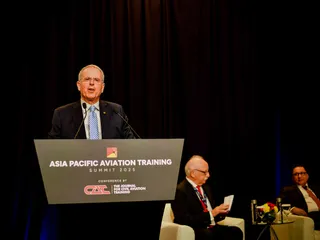APATS 2025 Keynote Urges Manual Flying Skills Training
Contact Our Team
For more information about how Halldale can add value to your marketing and promotional campaigns or to discuss event exhibitor and sponsorship opportunities, contact our team to find out more
The Americas -
holly.foster@halldale.com
Rest of World -
jeremy@halldale.com

Key Takeaways
- Loss of control in flight accounts for 60% of aviation fatalities in the Asia Pacific region
- 87% of surveyed airlines have adopted upset prevention and recovery training(UPRT)
- 76% of airline procedures discourage manual flying, contributing to skill deterioration
- Only 23% of pilots practice manual flying whenever possible; 20% only in training
- Critical shortage of qualified instructors and advanced simulator capabilities across the region
- Regulatory harmonization is urgently needed to standardize training practices
At the Asia Pacific Aviation Training Summit (APATS) 2025 in Singapore, Mitch Fox, Director of the Asia Pacific Centre for Aviation Safety at the Flight Safety Foundation, delivered a compelling call to action addressing critical gaps in pilot training across the region.
The Foundation's Regional Focus
The Flight Safety Foundation, established in 1945 as an international nonprofit organization with membership comprising over 1,000 organizations from 150 countries, opened its Asia Pacific Centre for Aviation Safety in Singapore in March 2023. This regional initiative aims to advance safety capabilities across the Asia Pacific.
Fox's presentation drew from two comprehensive studies conducted by the Centre: one examining the implementation of upset prevention and recovery training (UPRT), and another focusing on flight path management across the region.
Loss of Control: A Persistent Threat
The Centre's foundational analysis of aviation safety in the Asia Pacific revealed some alarming statistics.
"Loss of control in flight was the second-highest fatal accident occurrence category by raw number of occurrences," Fox reported.
From 2017 to 2023, five such accidents occurred in the region, with four proving fatal and resulting in 351 casualties.
Globally, this has been the leading cause of commercial aviation fatalities since 2011.
UPRT Implementation: Progress with Persistent Gaps
The Centre's UPRT study revealed encouraging progress alongside significant challenges. Fox reported that 87% of the surveyed operators are adopting the training into various stages of their programs, demonstrating a strong commitment to enhancing pilot capabilities. Additionally, 79% of the surveyed airline pilots express a high level of confidence in their UPRT skills.
However, substantial barriers remain. Airlines identified several critical challenges:
Resource Constraints and Infrastructure Gaps
Airlines cited limited access to advanced flight simulators, a shortage of qualified instructors, and the financial burden of upgrading facilities to meet ICAO standards as primary obstacles. Among approved training organizations (ATOs), 75% identified simulator upgrade costs as the most significant challenge, while 65% reported instructor shortages as critical barriers.
Regulatory Harmonization Needs
Fox emphasized that much of our community is actually looking to regulators for guidance to harmonize their training across national sectors. While 75% of responding ICAO states had developed aligned regulations, 50% were still creating supporting guidance materials, and 40% faced significant resource constraints.
The Manual Flying Crisis
Perhaps most alarming were the findings on flight path management and manual flying skills. Fox acknowledged that while "today's highly automated flight decks have resulted in safety improvements," there's a concerning trade-off: "many pilots today find that the opportunity to manually fly their airplanes has been remarkably reduced."
Automation Dependency
The study revealed striking statistics about manual flying practices:
· When asked "do your procedures encourage manual flying?" 76% of airline respondents said no
· Only 23% of pilots practice manual flying whenever possible
· 20% of pilots only practice manual flying during training
Fox warned that this "can result in an erosion of their ability, and quite possibly their confidence, in manually flying their airplanes."
Energy Management Deficiencies
Particularly concerning was the finding regarding energy management skills. "In the opinion of the survey respondents, understanding of energy management is only rated as excellent for 10% of the flight crew members," Fox reported. "This would seem to be a critical deficiency for crews operating sophisticated transport airplanes."
Data-Driven Evidence
The Centre's analysis of the Aviation Safety Network database provided compelling evidence of flight path management issues. Of 531 reported events from 2017 to 2023, 151 involved concerns related to flight path management. Critically, 15 of those events were cited by accident investigation organizations as causal or contributing factors to the events, including six fatal occurrences.
International Best Practices
Fox referenced successful initiatives by the FAA and EASA, noting how the joint Civil Aviation Safety Team (CAST) and Performance-based Operations Aviation Rulemaking Committee (PARC) study led to FAA Advisory Circular 121-23 on flight path management. However, he observed that "there appears to be very little regulatory guidance in the region concerning any aspect of flight path management."
A Community Call to Action
Fox concluded with an urgent appeal for collaborative action. "Flight path management can be considered an essential skill needed for upset prevention and recovery, and in fact, flight path management could even be considered the P in UPRT," he stated.
The Centre plans to facilitate development of regional guidance material based on international best practices, but Fox emphasized this "cannot be done in a vacuum. It can only be accomplished as a community effort involving regulators, airlines and ATOs and pilots."
Moving Forward
Both study reports will be made freely available on the Flight Safety Foundation website, providing the industry with comprehensive data to support improvement efforts. Fox's message was clear: "We have an extraordinarily safe system, but we must remain vigilant. We must be proactive, and we must address issues leveraging our ability to collaborate."
The path forward requires coordinated action across all stakeholders to address training gaps, enhance manual flying skills, and ensure pilots maintain the fundamental competencies needed to safely operate in an increasingly automated aviation environment.


